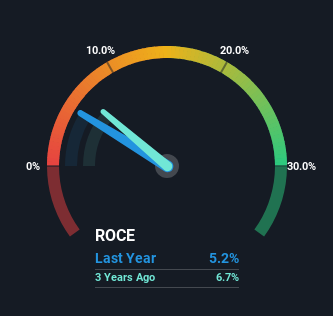Investors Met With Slowing Returns on Capital At Overseas Education (SGX:RQ1)
Did you know there are some financial metrics that can provide clues of a potential multi-bagger? Firstly, we'd want to identify a growing return on capital employed (ROCE) and then alongside that, an ever-increasing base of capital employed. Basically this means that a company has profitable initiatives that it can continue to reinvest in, which is a trait of a compounding machine. However, after briefly looking over the numbers, we don't think Overseas Education (SGX:RQ1) has the makings of a multi-bagger going forward, but let's have a look at why that may be.
Return On Capital Employed (ROCE): What Is It?
If you haven't worked with ROCE before, it measures the 'return' (pre-tax profit) a company generates from capital employed in its business. Analysts use this formula to calculate it for Overseas Education:
Return on Capital Employed = Earnings Before Interest and Tax (EBIT) ÷ (Total Assets - Current Liabilities)
0.052 = S$12m ÷ (S$262m - S$33m) (Based on the trailing twelve months to June 2023).
Therefore, Overseas Education has an ROCE of 5.2%. In absolute terms, that's a low return and it also under-performs the Consumer Services industry average of 8.9%.
View our latest analysis for Overseas Education
Historical performance is a great place to start when researching a stock so above you can see the gauge for Overseas Education's ROCE against it's prior returns. If you'd like to look at how Overseas Education has performed in the past in other metrics, you can view this free graph of past earnings, revenue and cash flow.
How Are Returns Trending?
Over the past five years, Overseas Education's ROCE and capital employed have both remained mostly flat. It's not uncommon to see this when looking at a mature and stable business that isn't re-investing its earnings because it has likely passed that phase of the business cycle. So unless we see a substantial change at Overseas Education in terms of ROCE and additional investments being made, we wouldn't hold our breath on it being a multi-bagger.
The Key Takeaway
In summary, Overseas Education isn't compounding its earnings but is generating stable returns on the same amount of capital employed. And with the stock having returned a mere 1.1% in the last five years to shareholders, you could argue that they're aware of these lackluster trends. As a result, if you're hunting for a multi-bagger, we think you'd have more luck elsewhere.
One more thing: We've identified 4 warning signs with Overseas Education (at least 1 which shouldn't be ignored) , and understanding these would certainly be useful.
While Overseas Education may not currently earn the highest returns, we've compiled a list of companies that currently earn more than 25% return on equity. Check out this free list here.
Have feedback on this article? Concerned about the content? Get in touch with us directly. Alternatively, email editorial-team (at) simplywallst.com.
This article by Simply Wall St is general in nature. We provide commentary based on historical data and analyst forecasts only using an unbiased methodology and our articles are not intended to be financial advice. It does not constitute a recommendation to buy or sell any stock, and does not take account of your objectives, or your financial situation. We aim to bring you long-term focused analysis driven by fundamental data. Note that our analysis may not factor in the latest price-sensitive company announcements or qualitative material. Simply Wall St has no position in any stocks mentioned.

